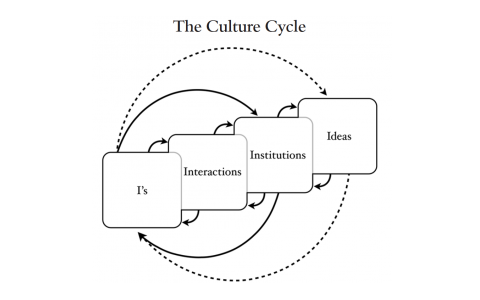Article summary
As a recent college graduate, it’s been exciting to apply things I learned in school to real-world scenarios. Not all of those topics have been totally relevant, but a few have definitely stuck with me. One is called the Culture Cycle, which is used to model the evolution of cultural norms and practices within social groups.
One such group where many of us belong is a company or organization, and luckily the Culture Cycle is just as relevant to the workplace as it is to large-scale societies. For those of you unfamiliar with it, I’d like to introduce the Culture Cycle, how it affects your workplace, and how you can use it to face culture-related problems. This post just covers the basics, but keep an eye out for a follow-up post that walks through some examples of the Culture Cycle in action.
What is the Culture Cycle?
The Culture Cycle is a model for understanding how people create, perpetuate, and alter culture inside of social groups. The model has four components: individuals, interactions, institutions, and ideas (also known as the Four I’s). The basic idea is that culture “flows” through these components, and that a cultural shift at any level will eventually propagate into the other three. Most texts or articles I’ve read about the model include some variation of the following illustration.

(Note that “I’s” in the first box is shorthand for “Individuals.”)
To summarize the picture above: People interact with each other and collectively form institutional structures. Both the institutions and people are affected and inspired by ideas. In a nutshell, this is how culture “happens” over time.
Individuals
People are the real agents of culture, since the other three components couldn’t exist without them. Every person has their own background, abilities, interests, volitions, goals, habits, preferences, personality, etc., which is why culture is able to evolve over time.
Note that everyone is affected by a number of cultures. For example, your work or school, your family, your friends, and your geographic contexts (e.g. your neighborhood, city, and country) each have a cultural impact on you. Each of these groups has its own Culture Cycle, and you also act as a cultural bridge between them.
Interactions
People communicate with each other in a myriad of channels—verbal speech, email, Slack, and body language, to name a few. Think about interactions as specific events, just not trends. For example, a specific email you sent to a coworker this morning fits this category, but the fact that your company uses Gmail instead of Outlook does not.
Obviously, interactions happen constantly within an organization. Depending on your role, you might interact mostly with people from outside of your organization (e.g. clients), or you might work almost exclusively with internal teams.
Institutions
In my opinion, this component is the most difficult to define. I think of institutions as human-made structures that guide people’s behavior. Institutions constitute a group’s rules, policies, practices, initiatives, and power hierarchies. They also represent less abstract environments, like your office space, and communication channels such as email service providers.
Ideas
Ideas are like heuristics that help people make decisions. Within a cultural context, ideas define how to live a good or happy life, how to be successful and virtuous, and how people should judge each other, among other things. They’re often captured within a culture as proverbs or maxims. In American culture, some of these include “the early bird gets the worm,” and “work hard, play hard.”
An important aspect of ideas is that they are not necessarily universally true. Instead, abiding by a culture’s ideology mainly benefits people inside that culture, because most of their peers share and encourage the same idea. For example, people of Western cultures tend to value independence, while people of Eastern cultures tend to value interdependence. Neither of these behaviors is definitively better than the other. But acting independently in the US is usually praised and encouraged, whereas acting independently in Japan is seen as less admirable and more of a faux pas.
Bringing the Four I’s Together
The lines in the illustration above represent the flow of culture between the Four I’s. There are a few subtleties to point out:
- Any component that affects another is also affected by that component. This shows the cyclical aspect of the model and is meant to illustrate how culture is self-perpetuating.
- Each component affects every other component, except interactions and ideas. I don’t think there’s a deep philosophical reason for this—the two just work at different levels.
- The lines between individuals and ideas are dotted. My interpretation is that, since ideas are totally abstract, these components only affect each other loosely.
Next Time
I hope this explanation of the Culture Cycle has been interesting so far. The really interesting part, though, is actually putting the model to use! Stick around for my next post, where I’ll walk through several situations where the Culture Cycle can be used to make smart decisions about guiding the culture of your company or organization.

